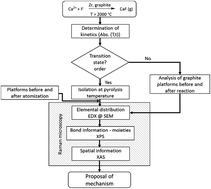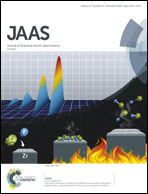Zirconium permanent modifiers for graphite furnaces used in absorption spectrometry: understanding their structure and mechanism of action†‡
Abstract
The mechanism of action of zirconium permanent modifiers on graphite surfaces was investigated in order to understand its influence on the analytical signal in atomic and molecular absorption spectrometry (AAS/MAS). For this, the molecule formation of CaF was studied, which is used for the indirect analytical determination of fluorine in high-resolution continuum source graphite furnace molecular absorption spectrometry (HR-CS-GFMAS). The kinetics of this reaction was established by monitoring its molecular spectrum at different atomisation temperatures. An Arrhenius plot showed a pseudo-first order reaction with respect to fluorine (n = 1). An intermediate state was isolated, and its structure was elucidated by spectroscopic methods: scanning electron microscopy with energy dispersive X-ray spectroscopy (SEM-EDX), X-ray photoelectron spectroscopy (XPS), X-ray absorption spectroscopy (XANES and EXAFS), and Raman microspectroscopy. We propose here a mechanism, where ZrO2 acts as a heterogeneous catalyst: after a pyrolytic step, an intermediate state of ZrO(OCaF) is activated, and at higher temperatures, CaF(g) is released from the zirconium-coated graphite surface. No evidence of the formation of zirconium carbide was found. Consequently, as the CaF formation is catalysed by a heterogeneous catalyst, surface modifications with ZrO2 nanoparticles and ZrO xerogels were investigated in order to increase the surface area. Their influence was evaluated in the molecule formation of CaF, CaCl, CaBr, and CaI. Graphite furnace modification with zirconium oxide nanoparticles proves to be the best choice for fluorine analysis with a signal enhancement of more than eleven times with respect a non-coated graphite furnace. However, the influence of zirconium modifications in the analytical signals of Cl, and I is lower than the F signals or even negative in case of the Br. Understanding zirconium modifiers as heterogeneous catalysts offers a new perspective to AAS and MAS, and reveals the potential of surface analytical methods for development of improved permanent modifiers and graphite furnace coatings.



 Please wait while we load your content...
Please wait while we load your content...